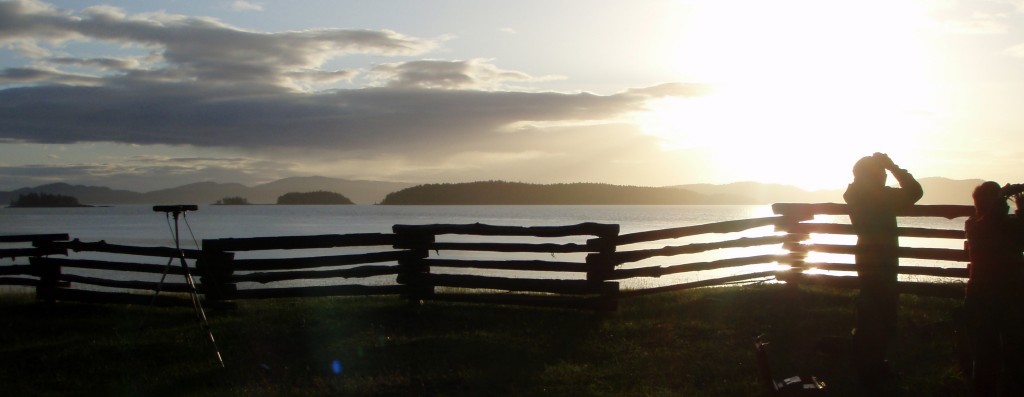The Future of Bioacoustic Monitoring
Deciphering a Dawn Chorus
When I first turned on the recording unit and listened I was amazed at the clarity of songs that filled my headphones on that summer morning on Portland Island, British Columbia. As many as a dozen species of songbirds were singing and calling, and I was able to pick out a few: the unique call of the rare Olive-sided flycatcher; the flute-like song of a Swainson’s thrush. Using a pair of microphones and a digital recorder, our field crew measured the songbird populations on Canada’s Southern Gulf Islands.
Advances in acoustic monitoring are changing how ecologists work, and recordings like mine not only complement traditional surveys, but offer up a powerful new way of seeing the world.
In Ithaca, New York, acoustic monitoring—and the nascent field of “bioacoustics”—is burgeoning, partly under the care of Russ Charif, a researcher with the Bioacoustics Research Program at the Cornell Lab of Ornithology. Charif’s team are world leaders in bioacoustics, having cut their teeth developing ways to decipher the intricate communications of marine mammals and songbirds, and building interactive software that has significantly advanced the process of analyzing acoustic data.
Using their software, known as Raven, Charif and his team can quickly parse through long spectrogram sequences which graphically represent the unique frequencies in a bird’s call. Each species’ call is distinct, meaning that anyone can pick out an Olive-sided flycatcher or Swainsons thrush, even without years of experience.
At least, that’s the idea.
One big challenge is the individual and site-specific variation in songbird dialects, a problem we encountered in the Southern Gulf Islands where even birds of the same species, but on neighbouring islands, would have different calls. Another is handling the reams of data captured by modern monitoring equipment.
Despite these hurdles, Charif said, the goal “is to be able to decipher a dawn chorus of boreal songbirds at the touch of a button.”
“But that day,” he admits, “is likely years away.”
Though I spent the morning recording on Portland Island, the real future of bioacoustic monitoring is in equipment that can be deployed remotely.
The Sounds of the Sea
While songbird-related work is increasingly part of Cornell’s bioacoustic research program, the lab’s main focus continues to be on marine mammals, especially those considered species-at-risk.
As offshore oil, gas, and wind projects have continued to boom, so to have worries about their effects on sensitive marine life. To meet the requirements of the U.S. Marine Mammal Protection Act, bioacoustic techniques have become a powerful tool for estimating population sizes and assessing the effects of industrial development on marine mammal activity.
Bioacoustic monitoring’s rise is partially due to the fact that there are few good options for monitoring in marine environments. Historically, marine mammals were tracked from aircraft or ships. Even under ideal circumstances, animals are difficult to spot. Bad weather makes it dangerous, and the darkness of night precludes it altogether. But marine ecosystems in particular are well-suited to bioacoustic technology: low frequency sound travels greater distances underwater than through air, and marine environments are often less acoustically-complex than their terrestrial equivalents, which tend to have higher levels of background noise.
Biacoustic Monitoring’s Expanding Range
In the past 30 years, bioacoustic monitoring in marine ecosystems has proven itself many times.
Off the northern coast of Alaska, acoustic techniques are used to measure the population of bowhead whales as they swim to their summer feeding grounds in the Beaufort Sea. This number is important since whales are still taken as part of a traditional subsistence hunt by native Alaskans and Canadians. Tracking shifting population, and using that information to gauge how many can be taken without hurting their numbers, is critical to the bowhead’s survival.
Bioacoustics is also being used to monitor right whale activity in Massachusetts Bay, after concerns arose that the development of an offshore gas terminal may be affecting the traditional migration corridor through the bay. The research found that the whales may be using part of the bay as more than just a migration route, a discovery that likely wouldn’t have been made with traditional monitoring techniques.
Increasingly, said Cornell’s Russ Charif, bioacoustics is being used to monitor everything from bats to elephants. And while he’s not sure where the technology will be in 10 or 20 years, he is certain there will be major developments in the next five as research is increasingly focused on broadening the range of applications.
As bioacoustic research expands its reach, we’ll continue to not only learn about the communication habits of other species, but about our role in the sonic landscape, and the effects of our noise on their biology and behaviour.
Press play to hear the call of an Olive-sided Flycatcher. Listen closely. Does it sound like “Quick, three beers” ?
Helpful Hint: If the audio file doesn’t show up on your screen it’s time to update your browser!

